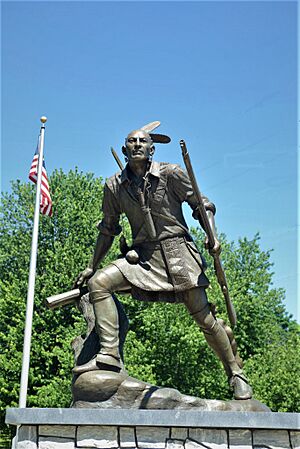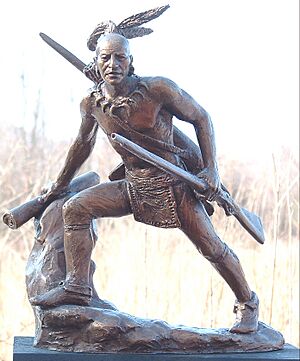Daniel Nimham facts for kids
Daniel Nimham (1726–1778) was an important leader, or sachem, of the Wappinger people. He was also a soldier in the American Revolutionary War. He was the most well-known Native American in the lower Hudson Valley during his time.
Contents
Who Were the Wappinger People?
Before Henry Hudson arrived in 1609, the Wappinger people lived along the eastern side of the Hudson River. They called the river Muhheakantuck, meaning "the river that flows both ways." Their land stretched from Manhattan Island north to Columbia County. It also went east into Connecticut.
The Wappinger were friends with the Mohican people to the north. They had camps along creeks and river branches. Larger villages were found where these streams met the Hudson River.
At the time Europeans first arrived, about 600 Wappinger people lived there. They lived in the highlands from Anthony's Nose to Fishkill Creek. Early writers noted three villages along the Hudson River. Their main village was Canopus, located in Putnam County. The Dutch and English called them "River Indians" or "Highland Indians."
Daniel Nimham's Early Life
Daniel Nimham led a group of 200 to 300 Mohican and Munsee-speaking Native Americans. They moved around the borderlands of Massachusetts, Connecticut, New York, New Jersey, and Pennsylvania. They built small homes from bark and logs in quiet valleys. These areas were far from colonial roads and towns.
They earned a living by weaving baskets and making brooms. They also worked as seasonal laborers on nearby farms. Daniel Nimham learned English by listening to his new neighbors.
After 1746, he lived near Great Barrington, Massachusetts. In 1755, during King George's War, he joined the English army. He served under Sir William Johnson. By 1758, he was a town constable in Stockbridge, Massachusetts.
He often visited his old lands around Wiccopee, New York. Until his death, he made a yearly trip up Mount Nimham in Kent. From there, he would look out over the land he still considered Wappinger territory.
He was said to stay in a camp at the base of Mount Nimham. This was the last known place where Wappinger people lived on their native land. A small group lived there as late as 1811.
Fighting for Land Rights
In 1697, a rich merchant named Adolphus Philipse bought land from two Dutch settlers. Philipse then made a new agreement with the Wappinger leaders. In this agreement, they gave up their claim to the land. Philipse said this agreement set the eastern border of his land.
During the French and Indian War, about 300 Wappinger men joined Rogers' Rangers. They moved their families to a Christian mission in Stockbridge during the war. When the men returned, they found their land rented out to farmers by the Philipse family.
Daniel Nimham likely learned English from Catheryna Rombout Brett's family. She lived in what is now Beacon, New York. She was friends with the Nimhams and let the Wappinger stay on her land even after it was sold. Most historians believe Daniel Nimham was born near Wiccopee, New York. Because he could speak both English and his native language, he went to court many times to protect his people's land.
Nimham argued that the Wappinger had been tricked out of their lands. The New York Council, which was controlled by powerful landowners, rejected Nimham's claim. They even put his legal helper in jail.
In 1766, Nimham and three Mohican chiefs traveled to England. They wanted to present their case to the royal Lords of Trade. Their trip was paid for by people who supported them. The London Chronicle described Nimham's group as tall and strong. One chief was "six and a half feet without shoes."
They were treated well in England. Nimham did not meet the King directly. But he spoke with a member of Parliament. This person agreed to contact the governor in Albany, New York.
The Lords of Trade said there was reason to investigate "frauds and abuses of Indian lands." They also said the actions of the New York governor seemed unfair. When Nimham's case was heard again in New York, a lawyer argued against returning the land. He said it would set a bad example for other land disputes.
The Stockbridge Militia
Daniel's son, Abraham Nimham (born in 1745), became a captain. He led a company of Native American scouts for the Continental Army. This group was called the Stockbridge Militia. It included Mohicans, Wappingers, Munsee, and other local tribes. General George Washington appointed Abraham as captain.
Daniel and Abraham Nimham fought for the American side in the American Revolutionary War. They were among America's first veterans. They served with Washington at Valley Forge. Later, they served with General Marquis de Lafayette. Daniel "faithfully served in the army as a soldier at Cambridge" in 1775.
On August 31, 1778, the Stockbridge Militia faced an attack. Fifty of their warriors, led by Nimham, were attacked by the Queen's Rangers. This was a Loyalist military unit led by Lt. Colonel John Graves Simcoe. The fight, known as the Battle of Kingsbridge, happened in what is now Van Cortlandt Park in the Bronx. A stone monument marks the trail to the battlefield. It honors the Stockbridge Militia who died there.
After the battle, Mohican Sachem Hendrick Aupaumut asked for help. He asked the General Court for money for the families who lost loved ones. Many young men had died in battle. Their wives and children were left without support. These families relied on hunting for food and clothing. But they could not hunt without their husbands. They also struggled to find places to trade for clothes.
By the early 1800s, many local Native Americans from Stockbridge joined the Oneida Nation in New York. They later moved west to Ontario and Wisconsin.
Legacy and Remembrance
- In 1906, a memorial for Chief Nimham was dedicated at Van Cortlandt Park in the Bronx, New York.
- Ninham Mountain in Kent, Putnam County, New York, is named after him. It rises to 1,260 feet.
- Lake Ninham in the town of Kent is also named after him.
- The Ninham Mountain Fire Tower, an 83-foot tall historic steel tower, stands atop Ninham Mountain.
- A marker on Gypsy Trail Road honors him. It says he was killed in 1778 while fighting at Kings Bridge with American forces. This marker is dated 1932.
- In 1932, the New York State Education Department put up a historical marker in Kent. A second marker was placed in 1937 in Fishkill.
- New York State's Ninham Mountain Multiple Use Area was created in Kent. This 1,054-acre property has many trails. It is popular for biking, hiking, and horseback riding.
- Since 2001, the Annual Daniel Nimham Intertribal Pow Wow has been held in Putnam County. Members of tribes from across the Northeast attend. They take part in dancing and other rituals. The event is open to the public.
- A sculptor named Michael Keropian made a small bronze sculpture of Nimham. This is part of a bigger plan to create a full-sized memorial in the Hudson Valley.
- In 2021, the Ninham Trail opened. It is an alternate route for hikers climbing Breakneck Ridge in Hudson Highlands State Park.
- In 2022, the Town of Fishkill dedicated an eight-foot bronze statue of Daniel Nimham. Sculptor Michael Keropian created it. The statue is located where a memorial plaque has stood since 1937.




